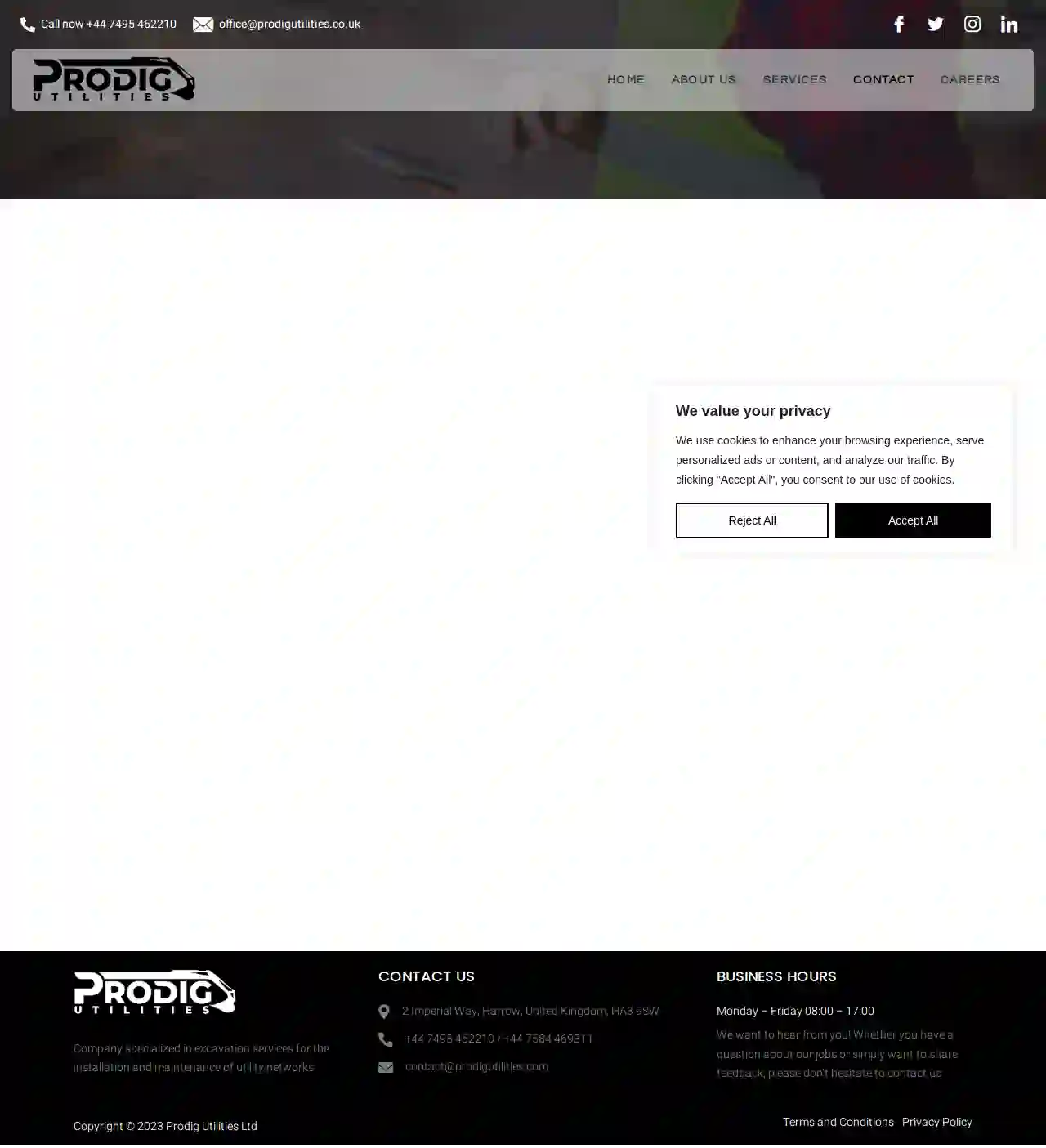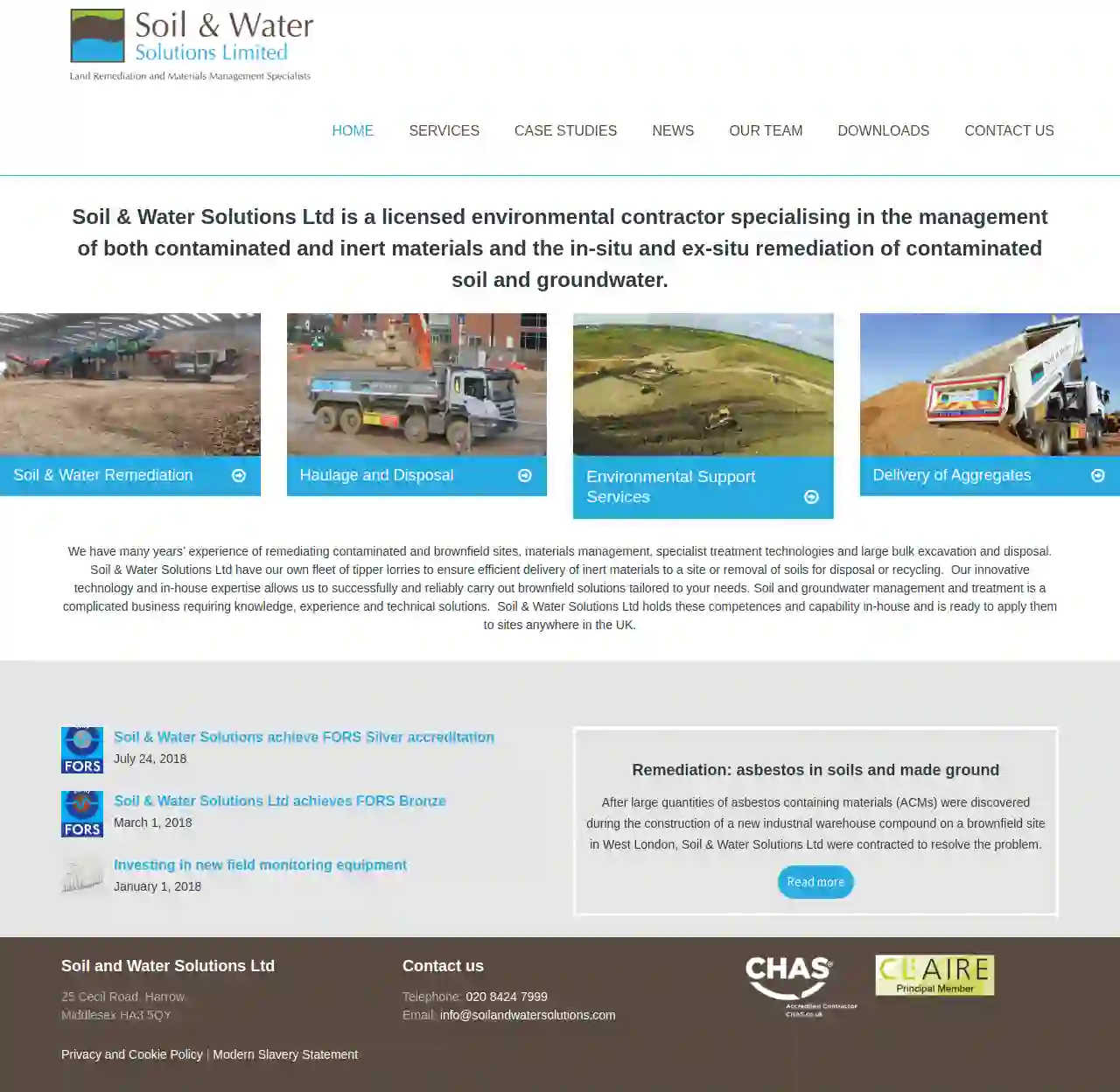Demolition Contractors Pinner
Top 10 Demolition Companies in Pinner
Get multiple Demolition Contractor quotes for your project today! Compare profiles, reviews, accreditations, portfolio, etc... and choose the best deal.

Prodig Utilities
12 Imperial Way, Harrow, HA3 9SW, GBUnderground utilities contractors Prodig Utilities Ltd is a company specialized in excavation services for the installation and maintenance of utility networks. We are dedicated to providing high-quality services with attention to detail and a focus on health and safety. About Us We are a team of experienced and skilled underground utility contractors providing high-quality services to clients across London, committed to delivering top-quality results while maintaining a safe and respectful work environment for everyone involved. “Our company was founded on the principles of integrity, professionalism and a commitment to excellence in everything we do.” Our Services We are a provider of reliable and efficient underground utility installation services for residential, commercial and industrial clients. At our company, we understand the importance of reliable and safe utilities, which is why we are committed to delivering high-quality services that meet all local and national regulations.
- Services
- Why Us?
- Gallery
Get Quote
Soil and Water Solutions Ltd
2.52 reviews25 Cecil Road, Harrow, Middlesex, HA3 5QY, GBSoil & Water Solutions Ltd is a licensed environmental contractor specializing in the management of both contaminated and inert materials and the in-situ and ex-situ remediation of contaminated soil and groundwater. We have many years’ experience of remediating contaminated and brownfield sites, materials management, specialist treatment technologies and large bulk excavation and disposal. Soil & Water Solutions Ltd have our own fleet of tipper lorries to ensure efficient delivery of inert materials to a site or removal of soils for disposal or recycling. Our innovative technology and in-house expertise allows us to successfully and reliably carry out brownfield solutions tailored to your needs. Soil and groundwater management and treatment is a complicated business requiring knowledge, experience and technical solutions. Soil & Water Solutions Ltd holds these competences and capability in-house and is ready to apply them to sites anywhere in the UK.
- Services
- Why Us?
- Gallery
Get Quote
Over 11,537+ Excavation Companies in our network
Our excavation pros operate in Pinner and surroundings!
ExcavationHQ has curated and vetted Top Excavation Contractors in and around Pinner. Find a top & reliable contractor today.
Frequently Asked Questions About Demolition Contractors
- Dust Suppression: Use water spraying, misting systems, or other dust suppression techniques to control airborne particles.
- Noise Barriers: Erect temporary noise barriers around the demolition site to reduce noise transmission to nearby properties.
- Work Schedule: Schedule noisy demolition activities during permitted hours to minimize disturbance to neighbors.
- Communication: Keep neighbors informed about the demolition schedule and any potential disruptions.
- Implosion: Using explosives to collapse a structure inwards rapidly. Suitable for large buildings in open areas.
- Wrecking Ball: Swinging a large steel ball to impact and break down the structure. Effective for bringing down walls and other solid elements.
- High-Reach Demolition: Utilizing specialized excavators with extended arms and demolition attachments for dismantling tall structures piece by piece.
- Selective Demolition: Removing specific parts of a building while preserving other sections. Often used in renovation projects.
- Deconstruction: Carefully dismantling a building to salvage reusable materials, reducing waste and environmental impact.
- Feasibility Studies: Assessing the viability and challenges of a demolition project.
- Demolition Planning: Developing demolition plans, including method selection, sequencing, and safety procedures.
- Permitting Assistance: Navigating the demolition permitting process and ensuring compliance with regulations.
- Hazardous Material Surveys: Identifying and managing hazardous materials, such as asbestos and lead paint.
- Cost Estimating: Providing accurate cost estimates for demolition services.
- Project Management: Overseeing the demolition process and ensuring it proceeds as planned.
- 'Can I see proof of your licensing and insurance?' Verify their credentials and coverage.
- 'What experience do you have with projects like mine?' Ensure they have relevant expertise.
- 'Can you provide references from past clients?' Check their reputation and customer satisfaction.
- 'What are your safety protocols?' Prioritize contractors who emphasize safety.
- 'How will you handle hazardous materials?' Ensure they have proper procedures for asbestos or lead abatement.
- 'What is your timeline for completing the project?' Understand the project duration.
- 'How will you manage noise, dust, and debris?' Discuss mitigation measures for minimizing disruption.
- 'What are your payment terms?' Clarify payment schedules and any required deposits.
How can I minimize the dust and noise from demolition?
What are the different types of demolition?
What is the role of a demolition consultant?
What questions should I ask a demolition contractor before hiring them?
How can I minimize the dust and noise from demolition?
- Dust Suppression: Use water spraying, misting systems, or other dust suppression techniques to control airborne particles.
- Noise Barriers: Erect temporary noise barriers around the demolition site to reduce noise transmission to nearby properties.
- Work Schedule: Schedule noisy demolition activities during permitted hours to minimize disturbance to neighbors.
- Communication: Keep neighbors informed about the demolition schedule and any potential disruptions.
What are the different types of demolition?
- Implosion: Using explosives to collapse a structure inwards rapidly. Suitable for large buildings in open areas.
- Wrecking Ball: Swinging a large steel ball to impact and break down the structure. Effective for bringing down walls and other solid elements.
- High-Reach Demolition: Utilizing specialized excavators with extended arms and demolition attachments for dismantling tall structures piece by piece.
- Selective Demolition: Removing specific parts of a building while preserving other sections. Often used in renovation projects.
- Deconstruction: Carefully dismantling a building to salvage reusable materials, reducing waste and environmental impact.
What is the role of a demolition consultant?
- Feasibility Studies: Assessing the viability and challenges of a demolition project.
- Demolition Planning: Developing demolition plans, including method selection, sequencing, and safety procedures.
- Permitting Assistance: Navigating the demolition permitting process and ensuring compliance with regulations.
- Hazardous Material Surveys: Identifying and managing hazardous materials, such as asbestos and lead paint.
- Cost Estimating: Providing accurate cost estimates for demolition services.
- Project Management: Overseeing the demolition process and ensuring it proceeds as planned.
What questions should I ask a demolition contractor before hiring them?
- 'Can I see proof of your licensing and insurance?' Verify their credentials and coverage.
- 'What experience do you have with projects like mine?' Ensure they have relevant expertise.
- 'Can you provide references from past clients?' Check their reputation and customer satisfaction.
- 'What are your safety protocols?' Prioritize contractors who emphasize safety.
- 'How will you handle hazardous materials?' Ensure they have proper procedures for asbestos or lead abatement.
- 'What is your timeline for completing the project?' Understand the project duration.
- 'How will you manage noise, dust, and debris?' Discuss mitigation measures for minimizing disruption.
- 'What are your payment terms?' Clarify payment schedules and any required deposits.